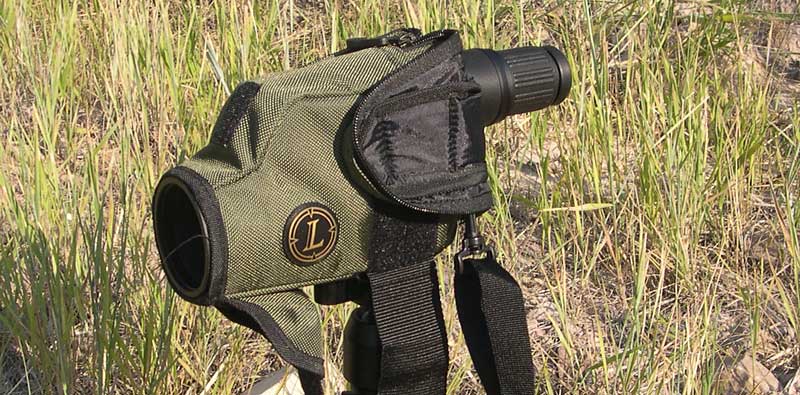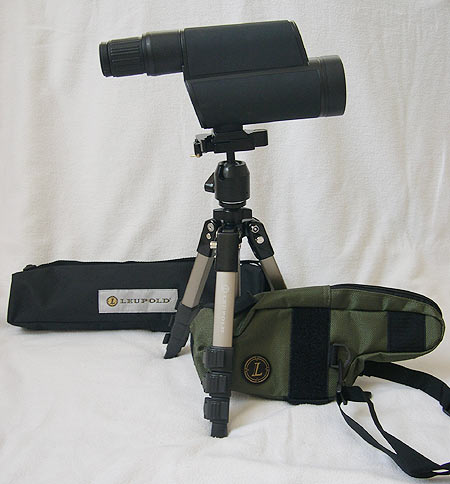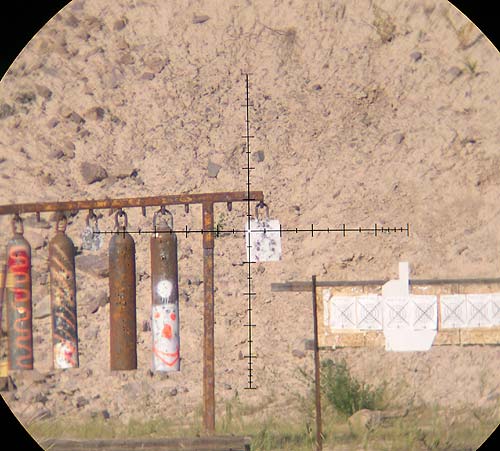
| Manufacturer: | Leupold |
| Model Number: | Mark 4 12-40x60mm |
| Finish: | Matte |
| Magnification: | 12.7-38.1x |
| Objective: | 60mm |
| Weight: | 37.0oz/1049g |
| Length: | 12.4"/315mm |
| Eye Relief: | 1.18"/30mm |
| Exit Pupil: | 4.8-1.5mm |
| Field of View @ 1000y: | 168'-52'/51.2m-15.8m |
| Close Focus: | 36'/11m |
| List Price: | $1260 |
| Street Price: | About $1260 (2006 price) |


|
The cover that comes with the scope is a very nice feature. It is a form fitting protective cover
that is intended to stay on the scope. It offers moderate protection to bumps and bangs and good
protection from scratches. The flip down front flap is attached at the top with velcro,
which of course is loud when trying to be tactical, but does work well. There is a velcro attach point
on the bottom for attaching the flap to keep it down and out of the way when in use. In the rear, over
the eyepiece, it is closed via a zipper, and on each side there is velcro to attach the side flaps
to keep them open. The top picture on this page shows the cover fully open and the scope ready
for operation. The bottom of the spotting scope has a standard mount threaded hole to be used on
any bipod. The green cover also has a flap that covers this when not mounted and again it folds
out of the way and attaches via velcro. A lot of velcro, so watch the noise discipline. I personally
like the compact size of the scope combined with the handy cover, it makes for easy transportation,
and it easily stuffs in the top of a ruck or even some large pockets. There is a carrying strap also, for
slinging it over the shoulder.
The optical quality of the spotting scope is typical Leupold high end quality. It is exceptional. The optics are clear and sharp all the way to the edges and the color contrast was very good. Picking up and reading trace and mirage was very easy and clear. It is hard to compare optics from various spotting scopes in a definitive manner, as it is hard to measure without very high end equipment (which we do not have). But I would say this scope compares very favorably to the Leica we reviewed, and is far superior to the Burris Landmark scope we also tested. Perhaps the edge in optical quality can slightly be given to the Leica, but it is a decent amount of money more than even this Leupold... and the Leupold has some other tricks up its sleeve that certainly gives it the edge over the Leica for tactical use. |
The controls of the scope are simple to use, with a magnification ring the furthest forward, and the focus closest to the user. A very nice feature is that there is two very different feels to the two controls. The mag ring is larger and smooth, and the focus is thinner with ridges. This allows for the ability to determine which control you are using by touch, and without taking the eye away from the scope. Another very nice feature was the generous eye relief. I was able to get a full and complete sight picture while wearing my glasses, not something many spotting scopes are able to do. The 12-40x zoom range of the scope is about perfect, providing great flexibility. There are no changeable eye pieces but I do not view that as a problem with this range and the capability of this scope.
So, what about that reticule being in the spotting scope? Is it everything I had hoped for? By golly, it is. The reticule itself is the traditional TMR reticule with the half mil marks and the hash marks instead of dots. A year or so ago I had some special order spotting scopes made for me in a fixed 20x with mildot reticules in them. The main problem I noticed was that the reticule itself took up a decent amount of viewing area and reading trace and mirage was interfered with. The solution that Leupold had to this was to remove the larger stadia and only show the mil portion of the reticule. It was a brilliant solution, as the reticule is hardly intrusive at all, especially in the lower mag ranges. The reticule itself is in the first focal plane, so it shrinks and grows with the different zoom levels. This is ideal for a spotting scope, allowing you to range at any zoom level.

The above picture shows the spotting scope on 40x looking at a 300yard target. The plate is about 16" tall. But you will notice that the reticule itself is non intrusive, and that you can get very accurate mil readings with the scope zoomed all the way in. Please keep in mind I was holding the camera by hand in all these reticule photos and it is very difficult to get a good picture. The optical quality of the scope is far better than what my compressed jpeg images show. But it does show you the reticule and how it looks through the scope.

Again, the digital image quality kind of hurts us on this photo also. This is looking at a house about 725 yards away on the lowest magnification of 12x. The reticule is almost lost in the image, but trust me, it is there and certainly readable. The idea is to compare how much more accurate your mil readings can be if you are able to zoom to 40x. This image in 12x is similar to what the reticule would be with a 10x riflescope trying to range the target. Now, compare that to the same target viewed in 40x

It is obvious the higher level of accuracy with mil readings you can obtain. The reticule works very well in this scope, and the optics are excellent which makes it even more attractive. I personally think this is the spotting scope to have for a military or law enforcement team. Until another one of the major spotting scope manufacturers puts a mildot reticule in their scope and meets the quality and well thought out design of this scope, this is the one to have. I am just excited that someone finally did it, and did it well. Of course, the down side is the cost, over $1200 for a spotting scope is a hard pill to swallow, but perhaps if there is enough interest, Leupold would release a more affordable PR version in the $500 range or so. We can only hope.
